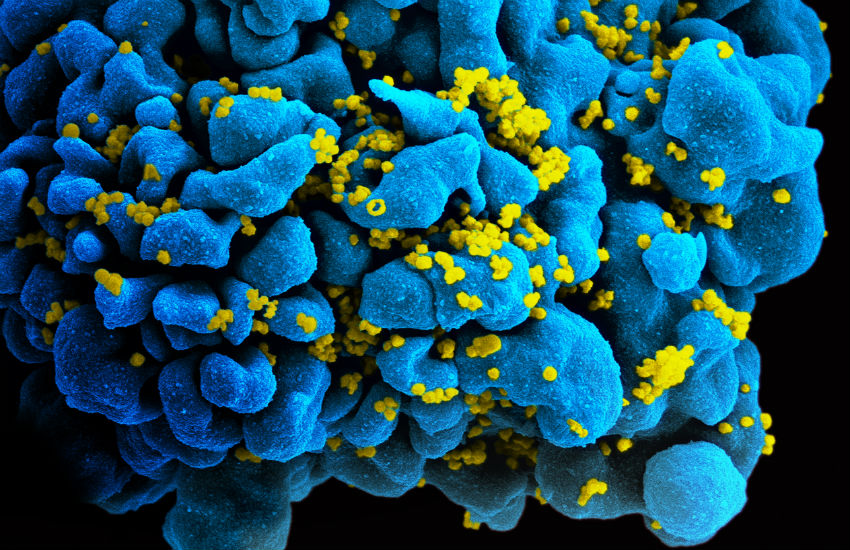A HIV-infected T cell (Photo: NIAID | Wikimedia Commons)
Public Health England today released new data on HIV transmission in the UK.
It reveals 4,363 people (3,236 males and 1,125 females) were diagnosed with HIV in 2017.
‘The 2017 figure represents a 17% drop from the 5,280 diagnoses reported in 2016 and a 28% drop from the 6,043 diagnoses in 2015.’
Gay and bisexual men represent the greatest downfall, with a drop of almost a third in diagnoses between 2015-2017 in that group.
The number of gay and bisexual men diagnosed in London has dropped even sharper: by 41% from 2015 to 2017.
The data also highlights trans people for the first time. There were 15 reported HIV diagnoses in trans women/non-binary individuals in 2015, falling to 8 in 2017.
Getting people to test regularly to cut down HIV diagnoses
Health services have been encouraging people to continue to test frequently. It’s widely accepted that people placed on treatment quickly, who achieve an undetectable viral load, cannot pass on the virus. This has become the core of the U=U campaign message: Undetectable equals untransmittable.
Many sexual health campaigners also believe the drop to be partly attributed to an increasing number of people accessing PrEP. This is a daily medication that can be taken to prevent someone acquiring HIV. However, PrEP remains widely available via the country’s National Health Service.
In England and Wales, 10,000 high-risk individuals are taking part in a PrEP trial to determine its cost efficiency. PrEP is now available via NHS Scotland. Other people are buying generic PrEP privately from online sites such as IWantPrEPnow.co.uk.
Public Health England say it is too early to conclude that the use of PrEP is contributing to the drop.
Although the fall in HIV diagnoses have been welcomed, there remains causes for concern.
Approximately 42% of people with HIV are still being diagnosed late. Heterosexual men and individuals aged 65 and over are the most likely to experience late diagnosis.
‘The impact of more HIV testing and faster access to treatment’
Matthew Hodson, Executive Director of HIV information organization NAM, said, ‘It’s fantastic that we have seen another reduction in HIV diagnoses. It shows that when we use all of the resources in our prevention armoury we can reduce infections.
‘The dramatic drop in HIV diagnoses, particularly among gay and bisexual men, shows the impact of more HIV testing and faster access to treatment.
‘This data also probably reflects the impact that PrEP has had, largely through gay and bisexual men buying it through sites like I Want PrEP Now. If more people at risk of HIV were able to get PrEP on the NHS we could achieve even more.
‘Late diagnosis remains a problem. Almost a third of gay men and bisexual men are diagnosed with a CD4 count below 350, which increases the risk of illness. We also see steeper drops in diagnoses in London, which means it’s likely that men outside of London are being diagnosed later.’
‘The tools to end the HIV epidemic’
Ian Green, Chief Executive at Terrence Higgins Trust, said: ‘Today’s drop in new HIV diagnoses among some communities in the UK clearly shows we have the tools to end the HIV epidemic in this country. But, rather than patting ourselves on the back, we need to redouble our efforts, work harder and get to zero HIV transmissions.
‘There is continued progress among some gay and bisexual men, particularly in London, with a 31% fall since 2015.
‘This turnaround in one of the groups most affected by HIV shows what can be achieved by utilising everything we’ve got in the fight against HIV. That includes the widespread availability of condoms, a range of ways and places to test for HIV, early diagnosis and access to treatment, and increasing the availability of HIV prevention pill PrEP.
Green also pointed out that women are often overlooked in HIV campaigns and conversations.
‘We welcome the inclusion of women only data tables for the very first time. But while around a quarter of new diagnoses continue to be among women, more needs to be done to ensure women are invisible no longer when it comes to HIV and properly included in HIV prevention campaigns.
‘Similarly, this year we also have trans specific data for the first time, which is so important in ensuring we have an accurate picture of how this group is impacted by HIV.’
See also
Not one case of HIV transmission from HIV positive gay men on effective treatment
Why we need to stop slut-shaming gay men who want condomless sex
Broadway performer reveals he’s HIV positive to help tackle stigma







